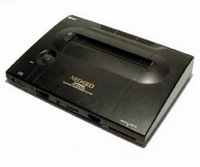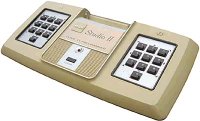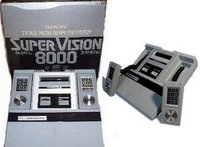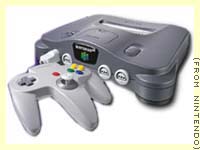
3DO Interactive
Similar to the goal of the Phillips CD-I, a company called 3D0 set out to create a new standard in multimedia. Their creation became the 3D0 Interactive Multiplayer. It was capable of running 3D0 interactive software (games), Audio CD’s, CD+G, Photo CD, and Video CD’s using an add on. Rather then manufacturing their new system, 3D0 decided to make 3D0 Interactive Multiplayer a franchise. Sanyo, Panasonic and Goldstar all bought rights to manufacture the 3D0 system. Once produced and sold, 3D0 would claim a royalty for each system and $3 for each game sold.

Pioneer LaserActive
What do you call a machine that lets you play music, games, Karaoke, interactive software and over 7,500 movies with the high-quality picture available?A $2000+ technical masterpiece that only the wealthy could afford.
The Pioneer LaserActive was a rare, expensive (unit alone $700), but interesting game playing machine. It was debuted to compete against the 3DO in October of 1993. It provided the ability to play games on Laser Discs (The precursor to the DVD).
The LaserActive used the MPEG-1 video standard for sharp / smooth FMV. It was capable of running popular arcade Laser Disc titles such as Dragon’s Lair and Space Ace.
Also available for the unit was a Laser Karaoke pack that retailed for $350. It came with a miniature mixer and microphone that could play over 250 titles. So how does this machine fit into the world of video game consoles? The Pioneer LaserActive used add-on devices called LD-ROM packs. Each pack retailed from $400 to $600 dollars. The first pack released was the Mega-LD pack that was developed in conjunction with SEGA Enterprises. This pack allowed you to play 8 and 12-inch LaserActive Mega-LD disks, Sega CDs, Genesis carts, and CD+G discs. The pack came with the Mega-LD game: Pyramid Patrol, and the four-in-one game CD that contained Revenge of Shinobi, Golden Axe, Streets of Rage, and Columns.

JVC X'Eye / WonderMega
JVC had helped Sega by delivering the most advanced sound made by a gaming console. A wider range of sounds not only gave the CD games more of an impact, but it was better then most audio CD players at the time. In return for their work, Sega gave JVC the "OK" to create this console. This system could play both Sega Genesis carts and Sega CD games in a single unit.
The Victor WonderMega (Model RG-M1) was released in Japan in April of 1992. At a debut price of 82,800 yen, the WonderMega was a costly version of something you could buy much cheaper by getting a Genesis and Sega CD separately. So why the heck was this machine built? (In case your wondering...JVC is also known as Victor Company of Japan. The letters are flopped of course)

FM Towns Marty
The FM Towns Marty, a.k.a. "FM Towns", a.k.a. "FM Marty Towns. A brief glance at this system, and you might mistake it for a white Turbo Duo, but on closer inspection, you'll notice that the slot on the front isn't for a HuCard, but instead for an actual 3.5" floppy. The Fujitsu Company decided to make an attempt to penetrate the console games market by taking their popular FM TOWNS line of computers, and adding in some special components to create a stand alone video game console. The plan was for the software designed for the FM TOWNS computers to be modified slightly so that the games would work on both the computer and the console. The FM Towns Marty has the distinction of being the first 32-bit video game console.

Atari Jaguar
With Sega and Nintendo battling neck and neck with their 16-bit platforms, Atari seized the opportunity to return to the console market after 7 years. A small company calling themselves 'Flare 1' were on the verge of developing a multiprocessor console. Needing the funding to develop it further, they approached Atari Corp. Atari was trying to develop their own console code named ‘Panther’at the time. They jumped on the offer, and development for the ‘Flare 2’ continued alongside the ‘Panther’. Eventually plans for the 32-bit Panther were scrapped for the renamed 64-bit Jaguar.
The Atari Jaguar was released in the United States on December of 1993. The console was manufactured by IBM. Atari boasted the system as being the first 64-bit console. They also boasted about a host of developers and a hundreds of games being created for the system. The system had amazing technical specs for it’s time. The console contained 5 processors mounted on 3 chips. One was a traditional Motorola 68000, and the other two were nicknamed ‘Tom’ and ‘Jerry’.

Sega CD / Mega CD
In 1991 at the Tokyo Toy show in Japan, Sega unveiled it’s secret project to compete against NEC’s PCEngine CD-ROM add on.
The Mega CD like it’s rival was capable of utilizing the enormous storage capacity of CD media to produce quality games. The Mega CD however was designed with it’s own processor and memory that worked in conjunction with the Megadrive’s (Genesis) processor and memory via an interface port.
The unit was capable of adding 10 extra sound channels to the Megadrive, and provide sprite enhancement features such as scaling and rotation, similar to that of the SuperNES’s Mode 7. Like other CD-based consoles, the Mega CD could also run audio CD’s and CD+G (CD plus Graphics). With the massive amount of storage space on CDs, game producers also saw the capability of using Full Motion Video (FMV) in their games. Unfortunately, when shown on a 16-bit console, the graphics turned out very pixilated and grainy, but that didn't stop them making such games.

Sega 32X / Mega 32X
It was the winter of 1994, and new more powerful consoles were entering the videogame market. Gamers were enjoying new 3D arcade games, and the 16-bit Genesis / Megadrive seemed to be feeling it’s age. It was January 8th 1994 when Sega CEO Hayao Nakayama directed his company to produce a 32-bit cartridge-based console to be in stores by Christmas 1994. The project was dubbed Jupiter. The project was given to ‘Sega of America’ while their Japan sector worked on a CD-Based console. Not happy with the idea of developing a simple console that had a 32-bit processor and more colors, Joe Miller of Sega of America chose to make the project an add on for the Genesis / Megadrive. Sega of America began development on the add on called project Mars without any knowledge of the 32-bit CD console being developed by their Japanese counterparts.

Bandai Playdia
The Playdia Quick Interactive System was one of Bandai’s next attempt at entering the videogame console industry. It was released in 1994 in Japan only, and marketed as a family oriented system.
Geared toward a younger audience, the Playdia was somewhat smaller then most consoles. It’s blue casing giving it a more “Toy” feel. The Playdia controller used infrared waves instead of cords and was made to be used either on or away from the machine (see images).
Using CD-based games, the Playdia could produce impressive anime style Full Motion Video (FMV). Most of the games were interactive educational titles. Bandai did however make a few interactive games based on their franchise series such as "Gundam", "Sailor Moon". “Ultra Man” and "Dragon Ball Z". However, the games lacked real gameplay. Simply being an interactive cartoon, the player simply instructs the onscreen character by selecting prompted menu choices using the Playdia control pad.

NEC PC-FX
With Sony and Sega releasing their 32-bit CD consoles on the market, NEC wanted a piece of the action. The maker of the successful PC Engine teamed up with 3rd Party software developer Hudson Soft of Japan to create a 32-bit CD based console capable of the highest quality FMV in any home video game system to date.
The NEC PC-FX strayed from the common console design. The console resembled a PC desktop tower, and even included 3 expansion ports for additional upgrades, and peripherals. NEC decided not to load it up with 3D generating hardware, and instead focused on making PC-FX a killer 2D machine. Focusing on FMV (Full Motion Video) and 2D capabilities, the PC-FX used a custom chip capable of Run Length JPEG compression technology. The result was animation and FMV using full screen true color at 30 frames per second.
The PC-FX is the king of systems for Anime and/or Hentai fans. The PC-FX could also play audio CDs (with an expansive CD menu control screen), CD+Gs, and Kodak CDs for viewing your home photos.

Neo Geo CD
Through the 1990’s SNK was ruling the arcades. Their cartridge based Neo Geo AES made their arcade hits playable at home, but the high price tag kept it out of the hands of many gamers. With other consoles switching game formats, SNK saw an opportunity to also use the large storage capacity of CD to make their hit games cheaper to manufacture. Of course this would make games more affordable to the general gaming public.
In 1994, SNK released the Neo Geo CD in Japan (and shortly after in the U.S).The Neo Geo CD did in fact make SNK titles affordable. SNK also used the CD storage medium to add new features to existing titles such as improved music, art galleries, hidden goodies, and new play modes.
Even with the cheaper cost, the console was plagued with unbearable load times. The Neo Geo CD used a single speed CD-ROM that had trouble loading larger game titles. This hurt console sales severely. SNK attempted to reduce game sizes and load times by removing some game frames, but in doing so also reduced the games overall quality.
In 1996 SNK took steps to speed up the console by adding a double speed CD-ROM. The redesigned unit called Neo Geo CDZ was released in limited quantities in Japan only. The console did speed games up somewhat, but had a design flaw that caused the console to overheat after limited gameplay time.


















































